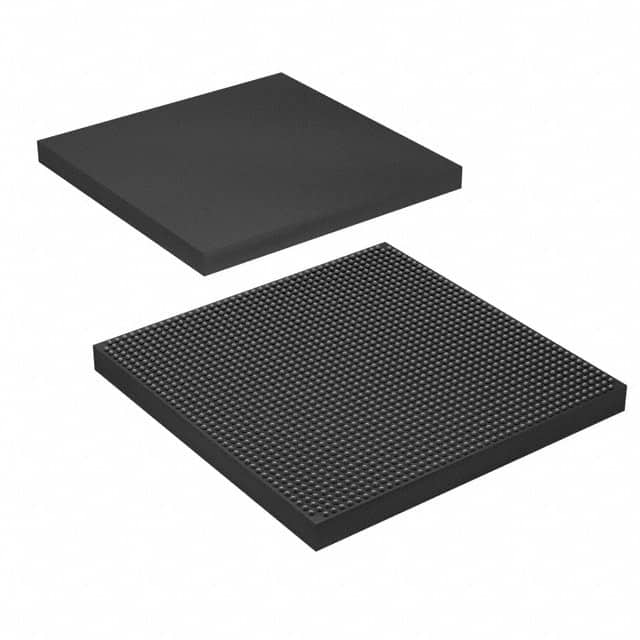Xem thông số kỹ thuật để biết chi tiết sản phẩm.

5SGXEB9R2H43C2N
Product Overview
Category
The 5SGXEB9R2H43C2N belongs to the category of Field Programmable Gate Arrays (FPGAs).
Use
FPGAs are integrated circuits that can be programmed and reprogrammed to perform various digital functions. The 5SGXEB9R2H43C2N is specifically designed for high-performance applications that require complex logic processing.
Characteristics
- High-performance FPGA with advanced features
- Large capacity for complex designs
- Low power consumption
- High-speed data processing capabilities
- Flexible and reprogrammable design
Package
The 5SGXEB9R2H43C2N comes in a compact and durable package, ensuring easy integration into electronic systems.
Essence
The essence of the 5SGXEB9R2H43C2N lies in its ability to provide a customizable and high-performance solution for digital logic processing.
Packaging/Quantity
The 5SGXEB9R2H43C2N is typically packaged individually and is available in various quantities depending on the requirements of the user.
Specifications
- Logic Elements: 220,000
- Embedded Memory: 8,062 Kbits
- DSP Blocks: 1,288
- Maximum User I/Os: 622
- Transceivers: 24
- Operating Voltage: 1.2V
- Operating Temperature Range: -40°C to 100°C
Detailed Pin Configuration
The detailed pin configuration of the 5SGXEB9R2H43C2N can be found in the product datasheet provided by the manufacturer.
Functional Features
- High-speed data processing capabilities
- Support for complex logic designs
- Configurable I/O standards
- On-chip memory for efficient data storage
- Built-in digital signal processing capabilities
- Flexible clock management
Advantages and Disadvantages
Advantages
- High-performance FPGA suitable for demanding applications
- Flexibility to reprogram the device for different functions
- Large capacity for complex designs
- Low power consumption compared to alternative solutions
- Support for various I/O standards
Disadvantages
- Higher cost compared to other programmable logic devices
- Steeper learning curve for programming and utilizing the full potential of the FPGA
Working Principles
The 5SGXEB9R2H43C2N operates based on the principles of configurable logic. It consists of a matrix of programmable logic elements, interconnects, and embedded memory blocks. The user can program the FPGA using hardware description languages (HDL) or design tools provided by the manufacturer. Once programmed, the FPGA executes the desired digital logic functions.
Detailed Application Field Plans
The 5SGXEB9R2H43C2N finds applications in various fields, including:
- Telecommunications: Used in high-speed data transmission systems, network routers, and switches.
- Aerospace and Defense: Employed in radar systems, avionics, and secure communication equipment.
- Industrial Automation: Utilized in control systems, robotics, and machine vision applications.
- Medical Devices: Integrated into medical imaging systems, patient monitoring devices, and diagnostic equipment.
- Automotive: Applied in advanced driver-assistance systems (ADAS), infotainment systems, and engine control units.
Detailed and Complete Alternative Models
- 5SGXEB7R2F40C2N
- 5SGXEB5R2F40C2N
- 5SGXEB3R2F40C2N
- 5SGXEB9R2F40C2N
- 5SGXEB7R2H43C2N
These alternative models offer similar features and capabilities to the 5SGXEB9R2H43C2N, but with varying specifications and capacities.
Note: The above content is a sample entry and may not reflect the actual specifications or details of the mentioned product.
Liệt kê 10 câu hỏi và câu trả lời thường gặp liên quan đến ứng dụng 5SGXEB9R2H43C2N trong giải pháp kỹ thuật
Sure! Here are 10 common questions and answers related to the application of 5SGXEB9R2H43C2N in technical solutions:
Q: What is the 5SGXEB9R2H43C2N FPGA used for? A: The 5SGXEB9R2H43C2N is a Field-Programmable Gate Array (FPGA) that can be used for various applications, including high-performance computing, networking, and signal processing.
Q: What are the key features of the 5SGXEB9R2H43C2N FPGA? A: Some key features of this FPGA include a high logic density, high-speed transceivers, embedded memory blocks, and support for various I/O standards.
Q: Can the 5SGXEB9R2H43C2N FPGA be reprogrammed? A: Yes, FPGAs are designed to be reprogrammable, allowing users to modify the functionality of the device even after it has been deployed.
Q: How can the 5SGXEB9R2H43C2N FPGA be programmed? A: The 5SGXEB9R2H43C2N FPGA can be programmed using hardware description languages (HDLs) such as VHDL or Verilog, or through graphical programming tools provided by the FPGA manufacturer.
Q: What are some typical applications of the 5SGXEB9R2H43C2N FPGA? A: This FPGA can be used in applications such as high-frequency trading, network routers, software-defined radios, video processing, and scientific research.
Q: Does the 5SGXEB9R2H43C2N FPGA support high-speed communication interfaces? A: Yes, this FPGA has built-in high-speed transceivers that support protocols like PCIe, Ethernet, and USB, making it suitable for applications requiring fast data transfer.
Q: Can the 5SGXEB9R2H43C2N FPGA interface with external memory devices? A: Yes, this FPGA has embedded memory blocks and supports various memory interfaces such as DDR3, DDR4, and QDR IV, allowing it to interface with external memory devices.
Q: What is the power consumption of the 5SGXEB9R2H43C2N FPGA? A: The power consumption of an FPGA depends on the design and usage scenario. It is recommended to refer to the device datasheet or power estimation tools provided by the manufacturer for accurate power consumption information.
Q: Can the 5SGXEB9R2H43C2N FPGA be used in safety-critical applications? A: FPGAs can be used in safety-critical applications, but additional measures need to be taken to ensure functional safety, such as implementing redundancy, fault detection, and error correction techniques.
Q: Are there any development boards available for the 5SGXEB9R2H43C2N FPGA? A: Yes, the manufacturer of the FPGA typically provides development boards that allow users to prototype and develop their designs using the 5SGXEB9R2H43C2N FPGA.
Please note that the specific details and answers may vary depending on the context and requirements of the technical solution being implemented.

